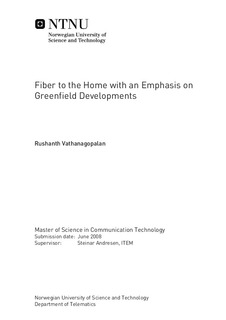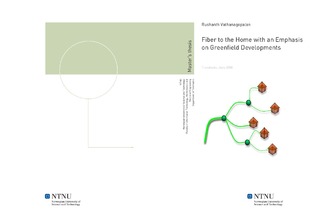| dc.description.abstract | Fibre-to-the-home (FTTH) is experiencing great public acceptance throughout the world, as well as in Norway. This thesis investigates the technological, economical and strategic aspects of FTTH with an emphasis on greenfield deployment. The thesis claims that the Active Optical Network (AON) and Gigabit Passive Optical Network (G-PON) are similar to some extent when compared to cost, while non-cost comparison shows that these two models have different qualities. Wavelength Division Multiplexing Passive Optical Network (WDM-PON) is commercially unavailable to a large degree for the time being, but would satisfy future needs better when it becomes standardised. The established passive infrastructure could also be considered for Wi-Fi services, and as feeder network for base stations for mobile broadband. Further, the report claims that the property developer should consider the opportunity to be the network owner in greenfield FTTH deployments in order to reduce the civil work costs. However, the ownership would vary with context for a particular FTTH deployment. Both open and closed business models are investigated and it is argued that both have advantages as well as disadvantages. Two different finance models are also briefly introduced in this thesis; two-part tariff pricing model and a price discriminating model, respectively. These are suggested as alternative ways of thinking, in order to address the various economic capabilities possessed by different customer groupings. The final part of the thesis is based on a case study of Lundåsen area in Trondheim, where a hypothetical greenfield FTTH deployment is evaluated. The cost expenditures (CAPEX) for each user were calculated to be almost 65% less than the norm for brownfield deployments in Norway. It is also estimated that the home price premium (the extra amount of money value added to price of a house) would be around 1% of the house price due to the fact that FTTH is implemented in the residence. Thus, this is a large contributor to the total revenues from a greenfield FTTH roll-out. The profitability analysis also showed a positive end result, thus indicating that FTTH roll-out in an analogous project like the case study should strongly be considered. | nb_NO |

